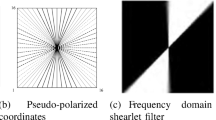Abstract
The fusion of infrared and visible images can obtain a combined image with hidden objective and rich visible details. To improve the details of the fusion image from the infrared and visible images by reducing artifacts and noise, an infrared and visible image fusion algorithm based on ResNet-152 is proposed. First, the source images are decomposed into the low-frequency part and the high-frequency part. The low-frequency part is processed by the average weighting strategy. Second, the multi-layer features are extracted from high-frequency part by using the ResNet-152 network. Regularization L1, convolution operation, bilinear interpolation upsampling and maximum selection strategy on the feature layers to obtain the maximum weight layer. Multiplying the maximum weight layer and the high-frequency as new high-frequency. Finally, the fusion image is reconstructed by the low-frequency and the high-frequency. Experiments show that the proposed method can obtain more details from the image texture by retaining the significant features of the images. In addition, this method can effectively reduce artifacts and noise. The consistency in the objective evaluation and visual observation performs superior to the comparative algorithms.





Similar content being viewed by others
Data availability
The code and the test vector map data associated with this paper can be found at https://github.com/diylife/imagefusion_deeplearning.git.
References
Du P et al (2020) Advances of four machine learning methods for spatial data handling: a review. J Geovis Spat Anal 4(1):13
Haghighat M, Razian MA (2014) Fast-FMI: non-reference image fusion metric. IEEE
He K, et al (2016) Deep residual learning for image recognition
Huang Y, et al (2017) Infrared and visible image fusion with the target marked based on multi-resolution visual attention mechanisms. In: Selected Papers of the Chinese Society for Optical Engineering Conferences held October and November 2016. International Society for Optics and Photonics
Kim M, Han DK, Ko H (2016) Joint patch clustering-based dictionary learning for multimodal image fusion. Inf fusion 27:198–214
Kumar BS (2015) Image fusion based on pixel significance using cross bilateral filter. SIViP 9(5):1193–1204
Li H, Wu X-J (2018) Densefuse: a fusion approach to infrared and visible images. IEEE Trans Image Process 28(5):2614–2623
Li S, Kang X, Hu J (2013) Image fusion with guided filtering. IEEE Trans Image Process 22(7):2864–2875
Li H, Wu X-J, Durrani TS (2019) Infrared and visible image fusion with ResNet and zero-phase component analysis. Infrared Phys Technol 102:103039
Liu Y et al (2016) Image fusion with convolutional sparse representation. IEEE Signal Process Lett 23(12):1882–1886
Liu Y et al (2017) Multi-focus image fusion with a deep convolutional neural network. Inf Fusion 36:191–207
Liu SP, Fang Y (2007) Infrared image fusion algorithm based on contourlet transform and improved pulse coupled neural network. J Infrared Millim Waves 26(3):217–221
Liu C, Qi Y, Ding W (2017) Infrared and visible image fusion method based on saliency detection in sparse domain. Infrared Phys Technol 83:94–102
Liu S, Tian G, Xu Y (2019) A novel scene classification model combining ResNet based transfer learning and data augmentation with a filter. Neurocomputing 338:191–206
Ma J et al (2017) Infrared and visible image fusion based on visual saliency map and weighted least square optimization. Infrared Phys Technol 82:8–17
Ma J et al (2020) Infrared and visible image fusion via detail preserving adversarial learning. Inf Fusion 54:85–98
Ma J, Ma Y, Li C (2019) Infrared and visible image fusion methods and applications: a survey. Inf Fusion 45:153–178
Prabhakar, KR, Srikar VS, Babu RV (2017) DeepFuse: a deep unsupervised approach for exposure fusion with extreme exposure image Pairs
Simonyan K, Zisserman A (2014) Very deep convolutional networks for large-scale image recognition. http://arxiv.org/abs/1409.1556
Toet A (2014) TNO Image fusion dataset. Figshare. data
Wang M et al (2019) Scene classification of high-resolution remotely sensed image based on ResNet. J Geovis Spat Anal 3(2):16
Wang Z, Bovik AC (2002) A universal image quality index. IEEE Signal Process Lett 9(3):81–84
Wu Y, Wang Z (2017) Infrared and visible image fusion based on target extraction and guided filtering enhancement. Acta Opt Sin 37(8):0810001
Xu L, Cui GM, Zheng CP (2017) Fusion method of visible and infrared images based on multi-scale decomposition and saliency region. Laser Optoelectron Prog 54(11):111–120
Yin H (2015) Sparse representation with learned multiscale dictionary for image fusion. Neurocomputing 148:600–610
Zhang Q et al (2013) Dictionary learning method for joint sparse representation-based image fusion. Opt Eng 52(5):057006
Zhu P, Ma X, Huang Z (2017) Fusion of infrared-visible images using improved multi-scale top-hat transform and suitable fusion rules. Infrared Phys Technol 81:282–295
Acknowledgements
This work is funded by the Natural Science Foundation Committee, China (No. 41761080, and No. 41930101) and Industrial Support and Guidance Project of Gansu Colleges and Universities, No. 2019C-04.
Author information
Authors and Affiliations
Contributions
LZ conceived, designed, and also wrote the manuscript; HL performed the experiments; RZ supervised the study; PD offered helpful suggestions and reviewed the manuscript. RZ and PD analyzed and evaluated the results.
Corresponding author
Additional information
Publisher's Note
Springer Nature remains neutral with regard to jurisdictional claims in published maps and institutional affiliations.
Rights and permissions
About this article
Cite this article
Zhang, L., Li, H., Zhu, R. et al. An infrared and visible image fusion algorithm based on ResNet-152. Multimed Tools Appl 81, 9277–9287 (2022). https://doi.org/10.1007/s11042-021-11549-w
Received:
Revised:
Accepted:
Published:
Issue Date:
DOI: https://doi.org/10.1007/s11042-021-11549-w




